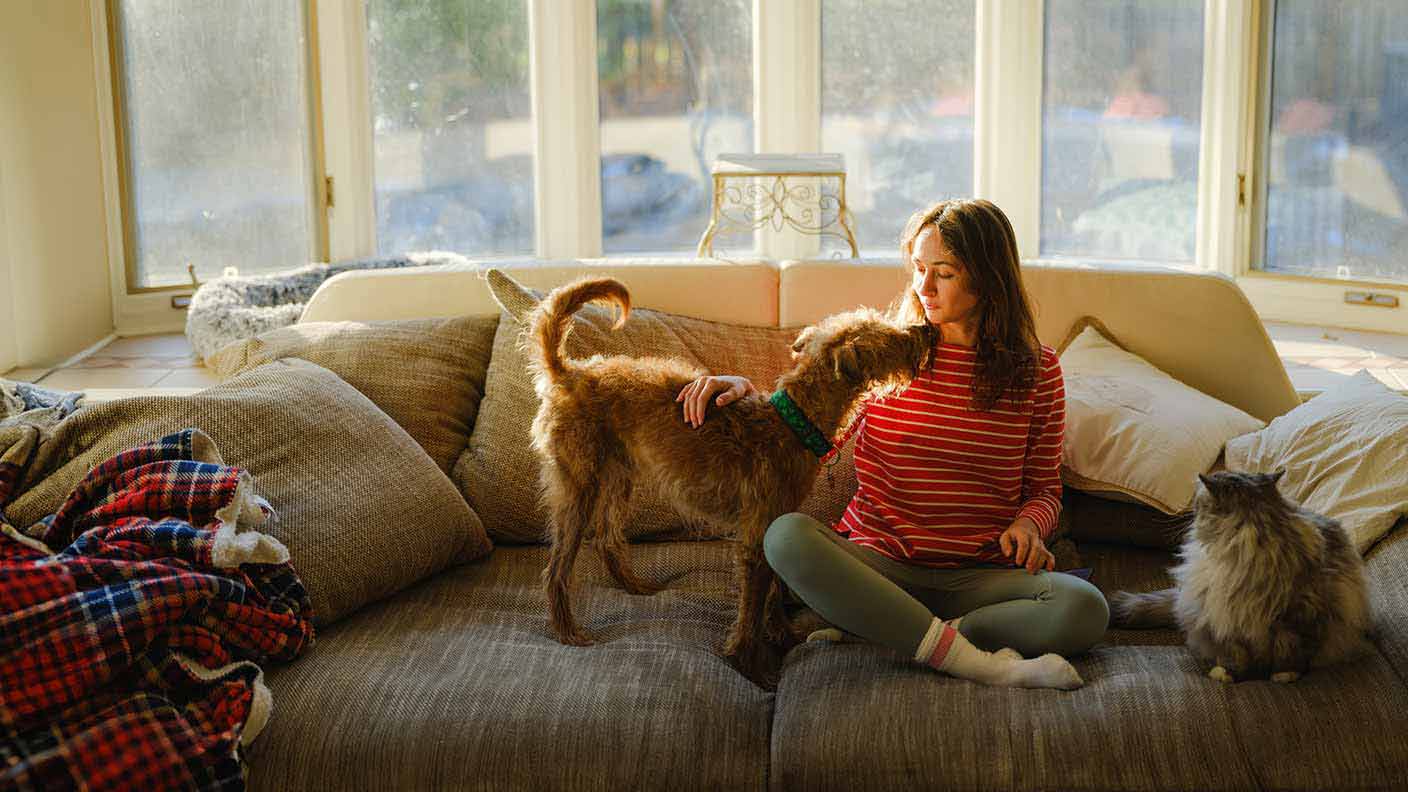Be prepared when your pet wanders off
We know how stressful and upsetting it can be when your pet goes missing. But if you prepare for the worst, you may have a better chance of finding them.
This detailed guide has practical hints and tips to consider if your pet is lost or stolen. And there are some simple steps you can take to reduce the risk of it happening in the first place.
Be pet-prepared
No pet parent wants to lose their four-legged friend. But if yours goes missing, there are steps you can take to try and get them back as soon as possible.
And there are measures you can take to minimise the risk of your pet going missing at all.
Collar and ID
Any pet wearing an ID tag is more likely to be returned to its owner if it goes missing. And remember it’s a legal requirement in the UK that dogs out in public must wear a collar or ID tag with their owner’s name and address.
Although collars are legally required for dogs, they can actually be dangerous for cats and rabbits – and can lead to injuries and choking.
Microchipping
Getting your pet microchipped is a safe and simple procedure that can help get your four-legged friend back if they’re ever lost or stolen. But how can a microchip really help you find your lost pet?
A tiny implant, around the size of a grain of rice, is injected under your pet’s skin. Each chip has a unique code, which links through to a file on a database. This file contains your contact details and important information about your pet, which will help reunite you with them if they go missing.
In the UK, all dogs over eight weeks old are required by law to be microchipped. If you don’t microchip your dog by the time it’s eight weeks old, you could face a fine. The fine could be up to £500, and our theft and straying cover would not apply.
Neutering
Non-sterilised pets are much more likely to wander off in search of a potential mate – so getting your pet neutered might be worth considering as a preventative measure.
This safe and simple surgical procedure, which prevents pets from reproducing, could reduce the risk of your pet going missing.
Missing pet kit
You might also want to think about getting a ‘missing pet kit’ together so you have relevant information handy if your pet does wander away. This kit could contain:
- Recent photos of your pet
- An in-depth description of your pet, including its age, weight, colour and details of any unique characteristics
- A collection of useful numbers, including local animal shelters, veterinary surgeries and the local police
- Important people to contact, including your vet and microchip company
- A list of any relatives or friends you and your pet have visited while on walks – it’s not unheard of for animals to show up at a home they’ve been to previously
Secure your premises
There are some simple steps you can take around the house to reduce the risk of your pet getting out and going missing:
- Make sure your gates and fences are sturdy, secure and high enough that your pet can’t escape
- Check for gaps under and between your gates and fences for rabbits, smaller dogs, house cats and other potential escape artists
- Make sure your windows and doors are closed and secured
Prepare pet-sitters
The risk of your pet going missing is typically higher if other people are looking after it.
So, if you’re planning to go away and need someone to take care of your pet, put together a checklist of things they need to be aware of, for example:
- Whether your pet can be let outdoors (or let off its lead outdoors)
- Any specific words or sounds your pet responds to
- Your contact details and your vet’s contact details in case of an emergency
Be aware of dognapping
So-called ‘dognappings’ – when criminals steal dogs to sell on the black market – are becoming increasingly common. To help reduce the risk of your dog being stolen:
- Look out for suspicious markings left on your property
- Be cautious of strangers asking you lots of questions about your pet, for example where you live or whether your pet has been neutered
- Avoid leaving your dog unattended in a yard or garden for long periods of time
Steps to take if your pet goes missing
If the worst ever happens and your pet does go missing, don’t panic. There are a number of steps you can take to hopefully get it back as soon as possible.
Get out and about
One of the first things to do is take a walk or drive around your local area to look for your pet.
Frightened animals might try to hide, so take a torch to search every nook and cranny.
Don’t forget to let your friends, neighbours and relatives know your pet is missing in case it shows up on their doorstep or they spot it wandering around.
Check local authorities and shelters
Lost and stray animals are handed into animal shelters every day, so check with your local shelter to see if they’ve got an animal fitting your pet’s description.
It’s worth contacting local authorities too, like your local council, animal warden or the police. They’ll likely be the ones who are contacted if your pet’s been in a car accident or is reported as a stray.
Use scents and sounds
Is there a sound or word your pet responds to? Or do they have a favourite treat or squeaky toy?
Using familiar scents and sounds could help retrieve your lost pet, so take them on your search and make some noise while calling your pet’s name.
Inform relevant organisations
As soon as you discover your pet is missing, inform the relevant organisations quickly, including local veterinary surgeries, humane societies and animal welfare and rescue centres.
The Pet Owners Association has a detailed directory of organisations across the UK that may be able to help. Pull together a list of local organisations you want to contact, then provide them with:
- A recent photo of your pet
- A detailed description of your pet, including its temperament
- Your pet’s microchip code (if applicable)
- Your contact details
Search national databases and registers
There are various databases and missing pet registers, usually run by charities, which may be able to help find your pet. Some of the most common services include:
Get the word out
Flyers, posters and leaflets can be a great way of encouraging local residents to keep an eye out for your pet.
Put your posters and flyers up around your local area and hand them into businesses including vets, shops and rescue centres. And don’t forget to spread the word on social media.
Your posters, leaflets and social media posts should include the following:
- Your missing pet’s name
- A brief description of your pet, including its breed, size and any distinctive markings
- A recent photo of your pet
- Your contact details
- Any reward you’re willing to pay if someone finds your pet
Check your pet insurance
If you have pet insurance, get in touch with your insurer as soon as possible – they may be able to give you financial assistance and advice.
When you take out Sainsbury’s Bank Pet Insurance for example, we’ll help towards costs for local advertising expenses or rewards you offer to try and find your missing pet.
And if you’ve lost your cat or dog and you’re unable to find them at all, we’ll reimburse the price you paid for them. This will be up to the limit set out in your certificate of insurance.
Got a missing pet rabbit? We can pay towards the costs of advertising and rewards – but theft and straying cover isn’t included with our rabbit insurance.
Tips on looking after your pets
To help you and your pets get the best out of each other, we’ve created a series of guides packed with tips and helpful information. They cover everything from heading off on holiday with your pets to making sure they’re happy in your home.

Microchipping your pet
See how microchipping can help find lost or stolen pets

Pet health and wellbeing
Find out how to keep your pet healthy and happy

Get a pet-friendly home
Hints and tips to help create the perfect pet pad
Any questions?
Get the answers you’re looking for by checking out our pet insurance customers’ most common questions.
Ready to protect your pet?
If you’d like to get a quote for your pet insurance, you can get started right away. If you’re ready, we’re ready.
Terms and conditions
Important information
*Guaranteed discount for Nectar members: The discount is based on information related to you and the transactions you've made with Sainsbury's supermarkets and Sainsbury's Bank using your Nectar card. For more information go to sainsburysbank.co.uk/nectar.
Sainsbury's Bank plc, Registered Office, 33 Charterhouse Street, London, EC1M 6HA (registered in England and Wales, no 3279730) is authorised by the Prudential Regulation Authority and regulated by the Financial Conduct Authority and the Prudential Regulation Authority (register no. 184514).
Sainsbury's Supermarkets Ltd is an appointed representative of Sainsbury's Bank plc. Sainsbury's Bank plc acts as an introducer to Pinnacle Insurance Ltd who is authorised by the Prudential Regulation Authority and regulated by the Financial Conduct Authority and the Prudential Regulation Authority (register number 110866). Registered office: 4th Floor, Limelight, Elstree Way, Borehamwood, Hertfordshire, WD6 1JH. Sainsbury’s Bank Pet Insurance is arranged, administered and underwritten by Pinnacle Insurance Ltd. Sainsbury's Bank plc and Pinnacle Insurance Ltd are not part of the same corporate group.
We do not provide personal recommendations to customers.
